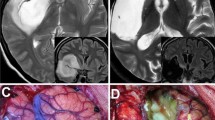Abstract
We reviewed our experience with diffuse brain stem glioma (dBSG) to evaluate whether any improvement of outcome had occurred in our patients over the years. Of the 24 children referred to our department with suspected dBSG from 1981 to 1997, 5 had a different final diagnosis based on the clinical course. Mean survival in the remainder was 16±9.8 months from diagnosis. Survival increased with a longer interval from onset of symptoms to diagnosis (12.9±9.0 months with an interval of 1–4 weeks; 19.50±10.8 months with a longer interval). Visual symptoms at presentation were associated with a poorer prognosis. Survival was better in the 3- to 5-year age group (at diagnosis). Overall, a trend toward a slight improvement in survival was seen over the years, which we presumptively attribute to the introduction of intensive chemotherapy for these patients. We suggest that chemotherapy may be important in the management of dBSG until a better modality is found.
Similar content being viewed by others
Author information
Authors and Affiliations
Additional information
Received: 10 May 1998
Rights and permissions
About this article
Cite this article
Shuper, A., Kornreich, L., Loven, D. et al. Diffuse brain stem gliomas Are we improving outcome?. Child's Nerv Syst 14, 578–581 (1998). https://doi.org/10.1007/s003810050275
Issue Date:
DOI: https://doi.org/10.1007/s003810050275




